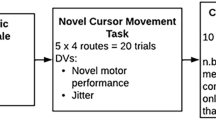Abstract
Studies of perception have focussed on sensation, though more recently the perception of action has, once more, become the subject of investigation. These studies have looked at acute experimental situations. The present paper discusses the subjective experience of those with either clinical syndromes of loss of movement or sensation (spinal cord injury, sensory neuronopathy syndrome or motor stroke), or with experimental paralysis or sensory loss. The differing phenomenology of these is explored and their effects on intention and agency discussed. It is shown that sensory loss can have effects on the focussing of motor command and that for some a sense of agency can return despite paralysis.
Similar content being viewed by others
Notes
All references are from ‘Still Lives’ The MIT Press, 2004, unless otherwise stated.
By natural embodiment I am distinguishing between an effortless background awareness of the body and a more attentional process which may follow neurological impairment.
LARSI; lumbar anterior root stimulation implant.
One person with tetraplegia actually wrote that his live was better after the injury than before, (Cole, 2004).
References
Brodal, A. (1973). Self observations and neuro-anatomical considerations after a stroke. Brain, 96, 675–694.
Cole, J. (1995). Pride and a daily marathon. Cambridge, MA: The MIT Press.
Cole, J. D. (2004). Still lives. Cambridge, MA: The MIT Press.
Cole, J, Gallagher, S., & McNeill, D. (2002). Gesture following deafferentation: A phenomenologically informed experimental study. Phenomenology and Cognitive Science, 1, 49–67.
Cole, J. D., Merton, L. W., Barrett, G., Treede, R.-D., & Katifi, H. (1995). Evoked potentials in a deafferented subject. Canadian Journal of Physiology and Pharmacology, 73, 234–245.
Farrer, C., & Frith, C. D. (2001). Experiencing oneself vs. another person as being the cause of an action: The neural correlates of the experience of agency. NeuroImage, 15, 596–603.
Ffytche, D. H., & Howard, R. J. (1999). The perceptual consequences of visual loss; ‘positive pathologies of vision. Brain, 122, 1247–1260.
Fourneret, P., & Jeannerod, M. (1998). Limited conscious monitoring of motor performance in normal subjects. Neuropsychologia, 36(11), 1133–1140.
Gallagher, S. (1986). Lived body and environment. Research in Phenomenology, 16, 139–170.
Gallagher, S. (2004). Neurocognitive models of schizophrenia: A phenomenological critique. Psychopathology, 37, 8–19 (with a response by Christopher Frith, “Comments on Shaun Gallagher.” Psychopathology, 37, 20–22).
Gandevia, S. C., Killian, K., McKenzie, D. K., Crawford, M., Allen, G. M., Gorman, R. B., et al. (1993). Respiratory sensations, cardiovascular control, kinaesthesia and transcranial stimulation during paralysis in humans. Journal of Physiology, 470, 85–107.
Gandevia, S. C., & Phegan, C. M. (1999). Perceptual distortions of the human body image produced by local anaesthesia, pain and cutaneous stimulation. Journal of Physiology, 514(Pt 2), 609–616.
Goldstein, K. (1939). The organism: A holistic approach to biology (p. 38). Boston, MA: Beacon.
Haggard, P., & Clark, S. (2003). Intentional action: Conscious experience and neural prediction. Consciousness and Cognition, 12, 695–707.
Haggard, P., Clark, S., & Kalogeras, J. (2002). Voluntary action and conscious awareness. Nature Neuroscience, 5(4), 382–385.
Lau, H. C., Rogers, R. D., Haggard, P., & Passingham, R. E. (2004). Attention to intention. Science, 303, 1208–1210.
Leder, D. (1990). The absent body. Chicago, IL: University of Chicago Press.
Libet, B., Gleason, C. A., Wright, E. W., & Pearl, D. K. (1983). Time of conscious intention to act in relation to onset of cerebral activity (readiness potential). The unconscious initiation of a free voluntary act. Brain, 106, 623–642.
Marcel, A. (2002). The sense of agency: Awareness and ownership of action. Chapter 2. In J. Roessler & N. Eilan (Eds.), Agency and self-awareness (pp. 48–93). Oxford: OUP.
Merleau-Ponty, M. (1962). Phenomenology of perception. London: Routledge.
Murphy, R. (1987). The body silent. New York: Henry Holt.
Paqueron, X., Leguen, M., Rosenthal, D., Coriat, P., Willer, J. C., & Danziger, N. (2003). The phenomenology of body image distortions induced by regional anaesthesia. Brain, 126, 702–712.
Reeve, C. (2002). Nothing is impossible; reflections on a new life. London: Century.
Sacks, O. (1984). A leg to stand on. London, UK: Duckworth.
Sacks, O. (1995). An anthropologist on Mars (p. xii). New York: Knopf.
Shoham, S., Halgren, E., Maynard, E. M., & Normann, R. A. (2001). Motor-cortical activity in tetraplegics. Nature, 413, 793.
Sirigu, A., Deprati, E., Ciancia, S., Giraux, P., Nighoghossian, N., Posada, A., et al. 2004. Altered awareness of voluntary action after damage to parietal cortex. Nature Neuroscience, 7(1), 80–84.
Wittgenstein, L. (1980). Remarks on the philosophy of psychology (p. 31e). Oxford, UK: Blackwell.
Wolpert, D. M. (1997). Computational approaches to motor control. Trends in Cognitive Sciences, 1, 209–216.
Acknowledgement
My thoughts in this area were initially stimulated by an invitation to lecture at the ASSC8 meeting in Antwerp in 2004. My thanks to Professor Patrick Haggard for organising the session.
Author information
Authors and Affiliations
Corresponding author
Rights and permissions
About this article
Cite this article
Cole, J. The phenomenology of agency and intention in the face of paralysis and insentience. Phenom Cogn Sci 6, 309–325 (2007). https://doi.org/10.1007/s11097-007-9051-5
Published:
Issue Date:
DOI: https://doi.org/10.1007/s11097-007-9051-5




